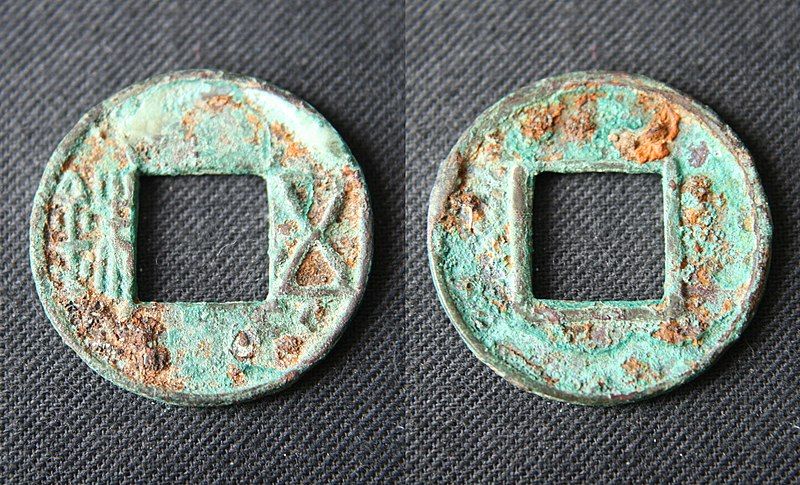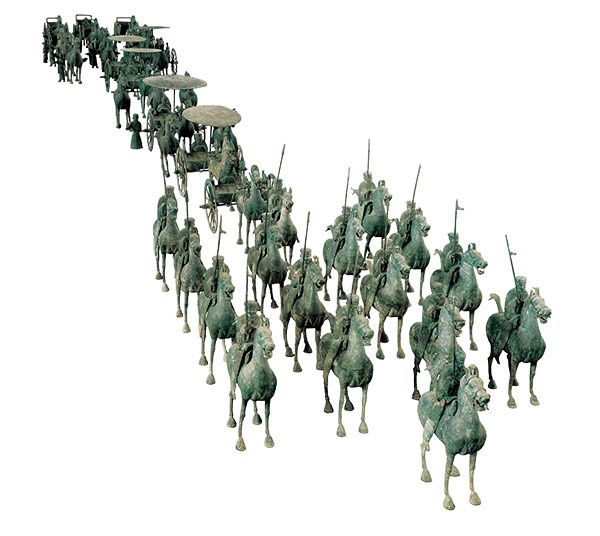Decline of Han Dynasty Shown Through 3 Artifacts
The decline of the Han dynasty in ancient China was a result of various factors, including external threats, government corruption, and the fragmentation of government power. These factors are supported by three artifacts: a handscroll depicting an interaction between the Han and nomadic groups, wuzhu coins issued during the period, and guards of honor figurines.
The first artifact showcases the "Barbarians and Envoys Bring Tribute to the Emperor" handscroll, featured in the image below.¹ Drawn in the style of 12th-13th century China, this artifact is said to depict envoys from the territories around China's periphery bringing tribute to the Han Dynasty emperor in the 1st century BCE. The depiction of interaction between the Han dynasty and nomadic groups reflects an ongoing historical pattern/continuity of tension, power struggle, and usually acrimonious exchanges between China and its neighbors that persist to the present day.

The use of artistic mediums such as ink and handscroll to document these historical events demonstrates the continuity of the cultural Chinese practice of recording events through visual art. In addition, this work represents the changes in the balance of power between the Han and nomadic groups during the decline of the Han dynasty. As internal political conflicts, peasant rebellions, and court excesses strained the resources of the Han government, it became increasingly difficult to maintain the military strength necessary to fend off these peripheral tribes from the Han's land.² These groups persistently pressured the Han dynasty's borders near the end of its reign, hastening its decline.
The second artifact are these wuzhu coins issued during the Han dynasty. These coins represent the change that occurred when the Han government tightened its control over the monetary system and coinage. In fact, a court debate in 81 BCE was the last serious challenge to the principle of a monopoly sovereign currency.³ This monopolistic government control of currency allowed Han officials to abuse their power by manipulating the currency for their own fiscal gain.
This corruption likely fueled inflation and resentment among the population toward the imperial government, weakening its legitimacy and contributing to the unrest and rebellions that contributed in bringing down the Han dynasty. The Han's inability to maintain a stable, trustworthy currency system was a factor in its eventual collapse.

In addition, the coins represent how Han emperors showed little interest in governing effectively, which made it difficult for the government to collect enough tax revenue to cover the lavish excesses of the imperial court and the military resources needed to defend against external threats like the nomadic groups. A change that occurred near the end of the Han dynasty was that the official government scholar folks managed to exempt themselves from paying taxes, resulting in the peasants bearing a heavier tax burden. The peasants even devised a system to alert each other when tax collectors were approaching their villages, allowing them to evade the collectors.⁴ These systemic problems led to a perpetually underfunded state.
The culmination of government corruption, heavy taxes, and general suffering was the Yellow Turban Rebellion. It was a peasant revolt occurring on March 184 CE during the reign of Emperor Ling of Han. The rebellion quickly gained nationwide support. Led by the Taoist commander Zhang Jue, the main rebellion was suppressed quickly by 185 CE. However, it took another 20 years to extinguish the remnant resistance and emerging rebellions. During this period, the power the imperial court held dramatically weakened.
In addition, the Han dynasty had faced a series of natural disasters, including droughts and floods, which severely damaged the agricultural output and led to widespread famine and suffering among the peasantry.⁵ This distress, coupled with the government's inability to provide relief and support, further fueled the resentment and discontent that manifested in the Yellow Turban Rebellion.
The third artifact, the "Guards of Honor Figurines" shown below represent the Han dynasty's response to the uprising which was initially ineffective, as they mobilized huge military forces at great cost but were hampered by inefficiency and corruption in the imperial government.⁶ It was not until the rise of the capable general Cao Cao that the Han were finally able to suppress the rebellion.⁷ This reliance on a single capable leader highlights the lack of strong, consistent leadership within the Han dynasty. The fact that it took the Han 20 years to fully extinguish the remnants of the rebellion shows the ongoing political and military challenges the dynasty faced, as the power of the imperial court had been dramatically weakened.

A significant change that occurred during the Yellow Turban Rebellion was the fragmentation of government authority. Local warlords, leaders, and provincial governors received increasing military power from the central government to quell the rebellion, further increasing the political instability and decentralization that undermined the Han's ability to effectively respond to major crises.⁸ In addition, this change allowed local leaders to challenge the central government's authority and ignore their directives.
In conclusion, multiple factors contributed to the decline of the Han dynasty. These include external threats posed by neighbouring nomadic tribes, government corruption stemming from the monopolistic control of fiscal currency, and the fragmentation of government power during the Yellow Turban rebellion. Throughout this blog post, I have shown how these factors are represented by various artifacts and how these artifacts demonstrate change and continuity.
Footnotes #
- "Barbarians and Envoys Bring Tribute to the Emperor." The Walters Art Museum, accessed May 11, 2024, https://art.thewalters.org/detail/409/barbarians-and-envoys-bring-tribute-to-the-emperor/
- Tribolet, Jack (2024) "Military Comparison of the Han Dynasty and the Roman Republic," Comparative Civilizations Review: Vol. 90: No. 1, Article 7.
- Dorn, James. "Monetary Freedom: Lessons from the Western Han Dynasty." Cato Institute, Oct 17, 2017, https://www.cato.org/blog/monetary-freedom-lessons-western-han-dynasty
- "Learning activity 3.4: Characteristics of societies in decline." TVO ILC, accessed May 11, 2024, https://course.ilc.tvo.org/d2l/le/lessons/22444446/topics/186821945
- Campbell, Dennis. "The Fall of the Han Dynasty", Khan Academy, accessed May 11, 2024, https://www.khanacademy.org/humanities/whp-origins/era-4-regional/41-systems-collapse-betaa/a/read-the-fall-of-the-han-dynasty-beta
- "Yellow Turbans." Britannica, accessed May 11, 2024, https://www.britannica.com/topic/Yellow-Turbans
- "Cao Cao." World History Encyclopedia, accessed May 11, 2024, https://www.worldhistory.org/timeline/Cao_Cao/
- "The Eastern Han Period." Lumen, accessed May 11, 2024, https://courses.lumenlearning.com/atd-herkimer-worldcivilization/chapter/the-eastern-han-period/
Bibliography #
"Barbarians and Envoys Bring Tribute to the Emperor." The Walters Art Mueseum, accessed May 11, 2024, https://art.thewalters.org/detail/409/barbarians-and-envoys-bring-tribute-to-the-emperor/
Campbell, Dennis. "The Fall of the Han Dynasty", Khan Academy, accessed May 11, 2024, https://www.khanacademy.org/humanities/whp-origins/era-4-regional/41-systems-collapse-betaa/a/read-the-fall-of-the-han-dynasty-beta
"Cao Cao." World History Encyclopedia, accessed May 11, 2024, https://www.worldhistory.org/timeline/Cao_Cao/
Cervantes, Ryann. "The 'Success' of the Yellow Turban Rebellion." StMU Research Scholars, accessed May 11, 2024, https://stmuscholars.org/the-success-of-the-yellow-turban-rebellion/.
Dorn, James. "Monetary Freedom: Lessons from the Western Han Dynasty." Cato Institute, Oct 17, 2017, https://www.cato.org/blog/monetary-freedom-lessons-western-han-dynasty
"The Eastern Han Period." Lumen, accessed May 11, 2024, https://courses.lumenlearning.com/atd-herkimer-worldcivilization/chapter/the-eastern-han-period/
"Learning activity 3.4: Characteristics of societies in decline." TVO ILC, accessed May 11, 2024, https://course.ilc.tvo.org/d2l/le/lessons/22444446/topics/186821945
Mark, Joshua. "The Mandate of Heaven and The Yellow Turban Rebellion.", World History Encyclopedia, accessed May 11, 2024, https://www.worldhistory.org/article/1461/the-mandate-of-heaven-and-the-yellow-turban-rebell/.
Szczepanski, Kallie. "The Yellow Turban Rebellion in China, 184 - 205 CE." ThoughtCo, Apr. 5, 2023, thoughtco.com/the-yellow-turban-rebellion-195122.
Tribolet, Jack (2024) "Military Comparison of the Han Dynasty and the Roman Republic," Comparative Civilizations Review: Vol. 90: No. 1, Article 7.
"Yellow Turban Rebellion." Britannica, accessed May 11, 2024, https://www.britannica.com/topic/Yellow-Turban-Rebellion.
"Yellow Turbans." Britannica, accessed May 11, 2024, https://www.britannica.com/topic/Yellow-Turbans